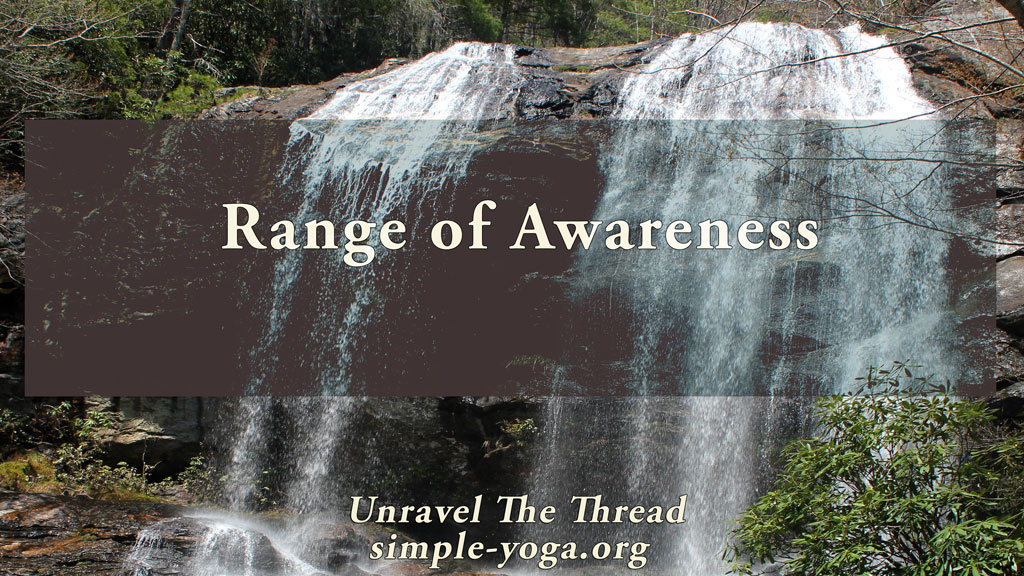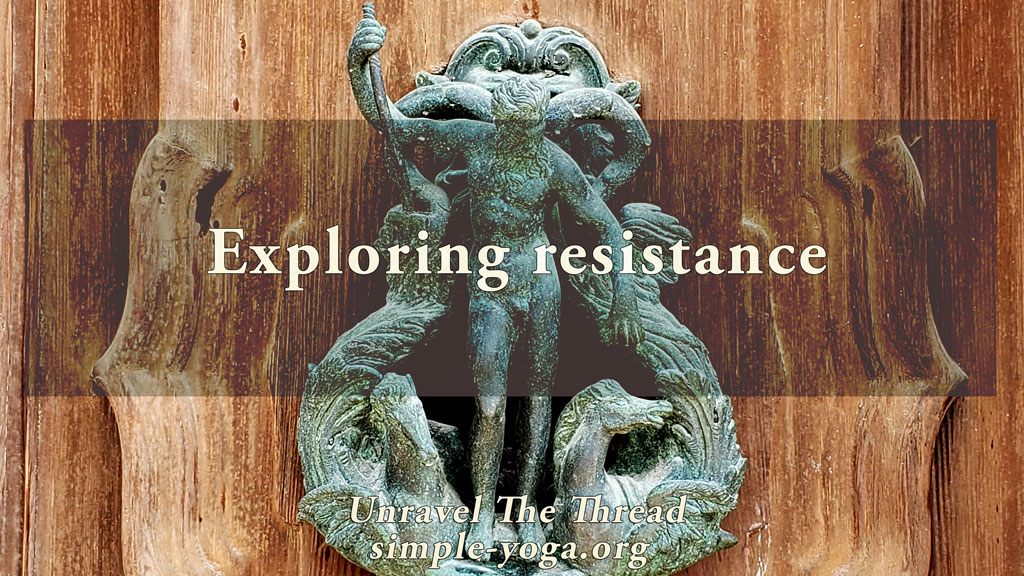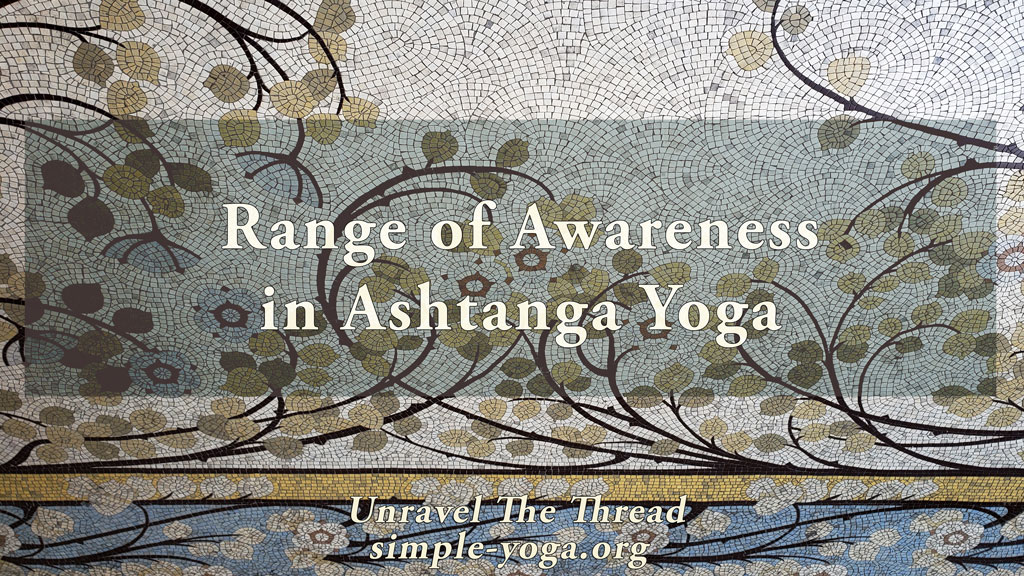
Range of Motion, Action, Awareness
January 16, 2024
Exploring resistance
February 7, 2024
Range of Motion, Action, Awareness
January 16, 2024
Exploring resistance
February 7, 2024Range of Awareness in Ashtanga Yoga

Range of Awareness in Ashtanga Yoga
In a previous episode, we reflected on the ideas of Range of Motion, Range of Action, and Range of Awareness, and suggested that Range of Awareness is a useful lens for understanding our yoga practice. One of the ways in which Range of Awareness can enhance our practice is by helping us to recognize that rather than always trying to push ourselves to the maximum limit of our capacity, there can also be benefits in considering what happens when we explore our practice from a more holistic perspective. In pranayama, for example, we explore our breath and all its possibilities according to its location, duration, and number of repetitions. It may be tempting to focus too much on expanding the depth and length of the breath. However, it can be helpful to recognize that in our meditation practice, we may end up breathing at a very minimal level rather than at our full capacity. Then, embodying the notion of range of awareness might help us include in our practice breathing exercises that, in addition to breath lengthening exercises, cultivate our sensitivity by attending to the shortest range of our breath. As a result, we develop familiarity with the full repertoire of options available for breathing, while also growing in our sensitivity to our internal processes, which is useful also for training our ability to concentrate.
Let’s think about the eight limbs of yoga presented by Patañjali in Sutra 2.29. First, remember that in Sutra 2.28, Patañjali told us the effects of practicing the eight limbs of yoga: Impurities are removed, wisdom (jñana) increases, and our ability to discriminate (viveka) grows. In other words, as a result of practicing all aspects of yoga, we are able to direct our awareness with greater clarity and precision.
In Sutras 2.30 and 2.31, Patañjali gave us the Yamas, wise ways of removing tension: Love (ahimsa), integrity (satya), fairness and generosity (asteya), curiosity and reverence for life (brahmacharya), and abundance and simplicity (aparigraha). The Yamas help us by making us aware of our assumptions, perceptions, and beliefs about the world and other people. The Yamas also invite us to become aware of how our assumptions, perceptions, and beliefs influence our intentions, actions, and interactions. From the perspective of range of awareness, living the Yamas tests our awareness of our emotions in relation to the people around us. One way to explore this idea is through the essential question we considered earlier.
Similarly, the Niyamas suggest wise ways to eliminate struggle : Clarity (shaucha), contentment (samtosha), enthusiasm (tapas), wisdom (svadhyaya), and humility (ishvara pranidhana). The Niyamas provide practitioners with a complete system for recognizing, understanding, and regulating our attitudes, intentions, and actions to create greater inner harmony. Each of these five guidelines can help us assess the range of our awareness of ourselves. The Best Friend or Worst Enemy reflection could be useful for contentment, and the Learning to Learn reflection can be applied for wisdom.
Although the skill of turning things around (pratipaksha bhavana) is not generally included in the eight limbs, Patañjali lists it immediately after explaining the Niyamas and before talking about the third limb, Asana. Pratipaksha bhavana serves as a reminder of the importance of gradual persistence in developing an uplifting attitude in life. This is underscored in Sutra 2.34 which lists the effects of its practice: Prevention of unending pain, imbalance and suffering. Pratipaksha bhavana is a simple way of noticing the strength of our resolve, while also reminding us that we are moving toward our goal at the pace that we can manage, which is a way to prevent frustration.
The practice of Asana deepens our awareness of our bodies by using posture, movement, balance and coordination to improve circulation, mobility, flexibility and sensitivity. This branch of yoga invites us to refine our awareness of our body, breath and mind while balancing strength and flexibility, avoiding unnecessary effort and eliminating distractions. In the practice of asana and vinyasa, we explore our range of awareness through questions like, What in my body is moving? What is contracting and what is relaxing? How can I regulate the intensity and speed of each action? How is my breath affected by this posture? And how does my breath affect my ability to move or stay in a particular position?
Pranayama, the fourth limb of yoga, is a conscious exploration of how our breathing processes affect our body, mood, and attention through a variety of breathing techniques. The practice of Pranayama makes it clear that the systematic regulation of our breathing processes enables us to develop greater sensitivity and steadier concentration. In addition to some of the considerations mentioned above, we can use the techniques in Pranayama as a way to expand our range of awareness of the many physical, physiological, mental and emotional effects of a variety of breathing techniques.
In today’s world, there are many opportunities to pay attention to the world outside our physical body. As our senses turn outward, our mind follows. The practices of Pratyahara invite us to explore our inner universe by turning our senses inward so that our awareness follows. Pratyahara is said to bring our senses under control . First, we expand our awareness of the internal state of our body. Then, as our awareness of our inner world grows, it can contribute to our ability to regulate our moods and emotions. In addition to improving our ability to concentrate, continuing this exploration can provide deeper insights into our tendencies and inclinations and into our own nature.
So far we have applied the concept of Range of Awareness to the first five limbs of the eight-limbed path of Ashtanga Yoga offered by Patañjali. It may be helpful to pause here to recognize how the idea of Range of Awareness can serve as a foundation for growing our practice while keeping all aspects of our yoga practice interconnected, as practicing each limb reinforces the other practices so that our sense of interior integration and harmony grows. Then it seems obvious that gradually deepening all aspects of the practice already prepares us for the next step in the journey.
As a result of the previous five limbs, our ability to focus our attention continues to grow, then concentration (dharana) unfolds organically. We explore our ability to focus our attention in spite of the many external and internal distractions. In the beginning, concentration may require more effort, especially to overcome the frustration of noticing our tendency to be distracted.
Patience and persistence in our practice lead us to develop the ability to maintain our focus with less effort, meditation (dhyana). This is how we grow in our inner stillness and silence. It is a process that continues to refine our awareness of greater subtleties and leads us to release many of the attachments we have consciously and unconsciously cultivated throughout our lives.
As we shed more and more of our fixed ideas, the formerly solid sense of identity and our investment in identifying with the temporary contents of our consciousness diminishes. Is it possible, then, that there is a higher level of inner integration without a sense of separateness? This is the promise of samadhi, the last stage in the journey.
Notice, indeed, that the entire journey of yoga leads us through an ongoing exploration of our range of awareness. How do these ideas relate to your current yoga practice? Is it possible that applying the idea of Range of Awareness to all aspects of your practice can enrich it?
If you prefer, you may listen to the podcast:
This is an excerpt from the book Unravel the thread: Applying the ancient wisdom of yoga to live a happy life
If you find Simple-Yoga.org and Unravel the thread useful, consider supporting my labor with a donation, you may also donate using PayPal or Venmo. Thank you!
